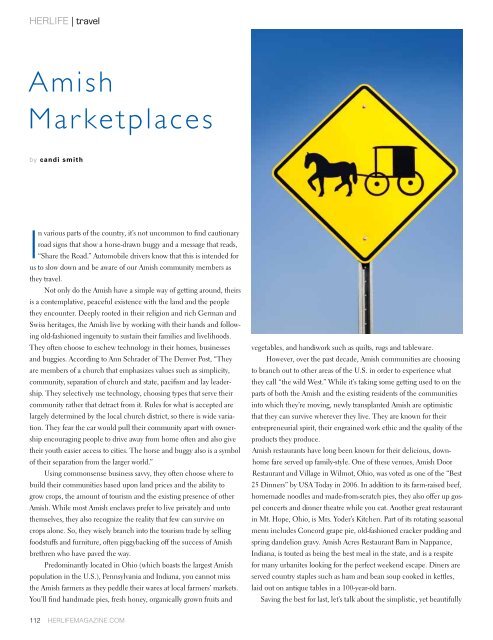Create successful ePaper yourself
Turn your PDF publications into a flip-book with our unique Google optimized e-Paper software.
herlife | travelAmishMar ketplacesby candi smithIn various parts of the country, it’s not uncommon to find cautionaryroad signs that show a horse-drawn buggy and a message that reads,“Share the Road.” Automobile drivers know that this is intended forus to slow down and be aware of our Amish community members asthey travel.Not only do the Amish have a simple way of getting around, theirsis a contemplative, peaceful existence with the land and the peoplethey encounter. Deeply rooted in their religion and rich German andSwiss heritages, the Amish live by working with their hands and followingold-fashioned ingenuity to sustain their families and livelihoods.They often choose to eschew technology in their homes, businessesand buggies. According to Ann Schrader of The Denver Post, “Theyare members of a church that emphasizes values such as simplicity,community, separation of church and state, pacifism and lay leadership.They selectively use technology, choosing types that serve theircommunity rather that detract from it. Rules for what is accepted arelargely determined by the local church district, so there is wide variation.They fear the car would pull their community apart with ownershipencouraging people to drive away from home often and also givetheir youth easier access to cities. The horse and buggy also is a symbolof their separation from the larger world.”Using commonsense business savvy, they often choose where tobuild their communities based upon land prices and the ability togrow crops, the amount of tourism and the existing presence of otherAmish. While most Amish enclaves prefer to live privately and untothemselves, they also recognize the reality that few can survive oncrops alone. So, they wisely branch into the tourism trade by sellingfoodstuffs and furniture, often piggybacking off the success of Amishbrethren who have paved the way.Predominantly located in Ohio (which boasts the largest Amishpopulation in the U.S.), Pennsylvania and Indiana, you cannot missthe Amish farmers as they peddle their wares at local farmers’ markets.You’ll find handmade pies, fresh honey, organically grown fruits andvegetables, and handiwork such as quilts, rugs and tableware.However, over the past decade, Amish communities are choosingto branch out to other areas of the U.S. in order to experience whatthey call “the wild West.” While it’s taking some getting used to on theparts of both the Amish and the existing residents of the communitiesinto which they’re moving, newly transplanted Amish are optimisticthat they can survive wherever they live. They are known for theirentrepreneurial spirit, their engrained work ethic and the quality of theproducts they produce.Amish restaurants have long been known for their delicious, downhomefare served up family-style. One of these venues, Amish DoorRestaurant and Village in Wilmot, Ohio, was voted as one of the “Best25 Dinners” by USA Today in 2006. In addition to its farm-raised beef,homemade noodles and made-from-scratch pies, they also offer up gospelconcerts and dinner theatre while you eat. Another great restaurantin Mt. Hope, Ohio, is Mrs. Yoder’s Kitchen. Part of its rotating seasonalmenu includes Concord grape pie, old-fashioned cracker pudding andspring dandelion gravy. Amish Acres Restaurant Barn in Nappance,Indiana, is touted as being the best meal in the state, and is a respitefor many urbanites looking for the perfect weekend escape. Diners areserved country staples such as ham and bean soup cooked in kettles,laid out on antique tables in a 100-year-old barn.Saving the best for last, let’s talk about the simplistic, yet beautifully112 <strong>HERLIFE</strong>MAGAZINE.COM
















